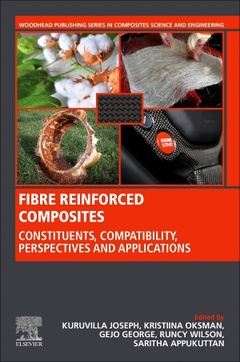Fiber Reinforced Composites Constituents, Compatibility, Perspectives and Applications Woodhead Publishing Series in Composites Science and Engineering Series
Coordonnateurs : Joseph Kuruvilla, Oksman Kristiina, Gejo George, Wilson Runcy, Appukuttan Saritha

Polymer-based fibre-reinforced composites FRC?s have now come out as a major class of structural materials being used or regarded as substituent?s for metals in several critical components in space, automotive and other industries (marine, and sports goods) owing to their low density, strength-weight ratio, and fatigue strength. FRC?s have several commercial as well as industrial applications ranging from aircraft, space, automotive, sporting goods, marine, and infrastructure. The above-mentioned applications of FRC?s clearly reveal that FRC?s have the potential to be used in a broad range of different engineering fields with the added advantages of low density, and resistance to corrosion compared to conventional metallic and ceramic composites. However, for scientists/researchers/R&D?s to fabricate FRC?s with such potential there should be careful and precise design followed by suitable process development based on properties like mechanical, physical, and thermal that are unique to each application. Hence the last few decades have witnessed considerable research on fibre reinforced composites.
Fibre Reinforced Composites: Constituents, Compatibility, Perspectives and Applications presents a widespread all-inclusive review on fibre-reinforced composites ranging from the different types of processing techniques to chemical modification of the fibre surface to enhance the interfacial adhesion between the matrix and fibre and the structure-property relationship. It illustrates how high value composites can be produced by efficient and sustainable processing methods by selecting different constituents [fibres and resins]. Researchers in academia working in composites and accompanying areas [materials characterisation] and industrial manufacturers who need information on composite constituents and how they relate to each other for a certain application will find the book extremely useful when they need to make decisions about materials selection for their products.
1. An introduction to fibre reinforced composite materials 2. Various fabrication methods employed in fiber reinforced composites 3. Surface treatments in fibre reinforced composites 4. Machining of Composite Materials 5. Thermoplastic natural fibre based Composites 6. Biobased polyamide reinforced with natural fibre composites 7. Elastomer matrix based natural fibre composites 8. Thermosetting natural fibre based composites 9. Polymer Blend Natural Fibre based Composites 10. Biodegradability studies of lignocellulosic fiber reinforced composites 11. Carbon and Glass Fiber Reinforced Thermoplastic Matrix Composites 12. Carbon fiber and Glass fiber reinforced elastomeric composites 13. Thermosetting matrix-based glass and carbon fibre composites 14. Recent toughening strategies in carbon fibre reinforced composites 15. Commingled composites 16. Hollow fibre reinforced polymer composites 17. Metal fibre reinforced composites 18. Aramid fibre reinforced composites 19. Recycling of fibre reinforced thermosetting composites 20. Fibre reinforced cement-based composites 21. Fibre reinforced metal matrix composites 22. Continuous Fibre reinforced ceramic matrix composites 23. Industrial and biomedical applications of fibre reinforced composites 24. Automotive and construction applications of fibre reinforced composites 25. Fiber reinforced composites for aerospace and sports applications
Prof. Oksman has been chair professor and director of Composite Centre at Luleå University of Technology, Division of Materials Science, since 2006 and Adjunct Professor at the University of Toronto, Faculty of Forestry, Canada since 2006. She is the editor on Biocomposites for Elsevier’s Composites Part A. Prof. Oksman has been working with natural fiber composites for more than 25 years and the last 12 years focusing on biobased nanocomposites and their property characterization and processing. Other research activities have also included biocarbon and electrospinning of biopolymers. She has more than 300 scientific publications and conference proceedings in the field of nanostructured biomaterials and biocomposites and is highly cited. Her H index is 67 and i10 index is 166 with a total citation of 20700. Her main expertise is the fundamental understanding of nanomaterials and composites, their processing development and the relationship between the manufacturing process, the structure and properties.
Dr. George obtained his PhD in Chemistry from Kalasalingam University, Tamil Nadu, India in 2014, specializing in the area of commingled natural fiber composites. He published several articles in high-impact journals (Composite Part A, Comp
- Focuses on the different types of FRC’s that are currently available (e.g. from polymeric matrices to metallic and ceramic matrices, from carbon fibre to different types of natural fibres and from short to long fibre reinforced), their processing techniques, characterization of different properties, and how to improve the interfacial adhesion between an incompatible fibre and matrix and their applications
- Looks at crisis areas such as how to incorporate incompatible fibres and matrices together (e.g. Non-polar polypropylene matrix is not compatible with that of polar natural fibres and hence suitable surface modifications are required to make them compatible with each other) along with low cost processing methods, low density and high strength
- Uncovers clarifications to both elementary and practical problems related to the fabrication of FRCs
- Schematic representations depicting the interaction between different fibre types and matrices will be provided in some chapters
Date de parution : 03-2021
Ouvrage de 906 p.
15x22.8 cm



